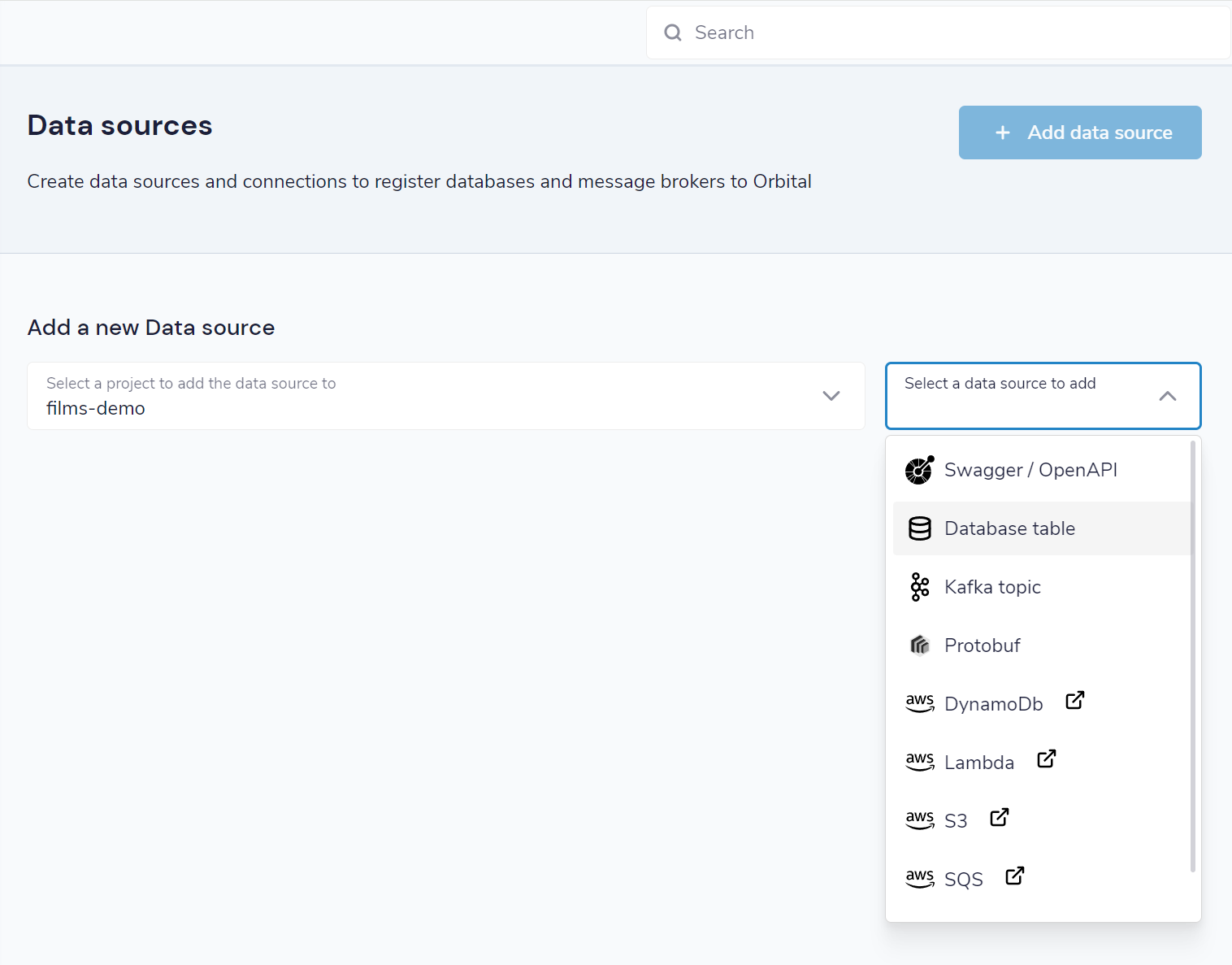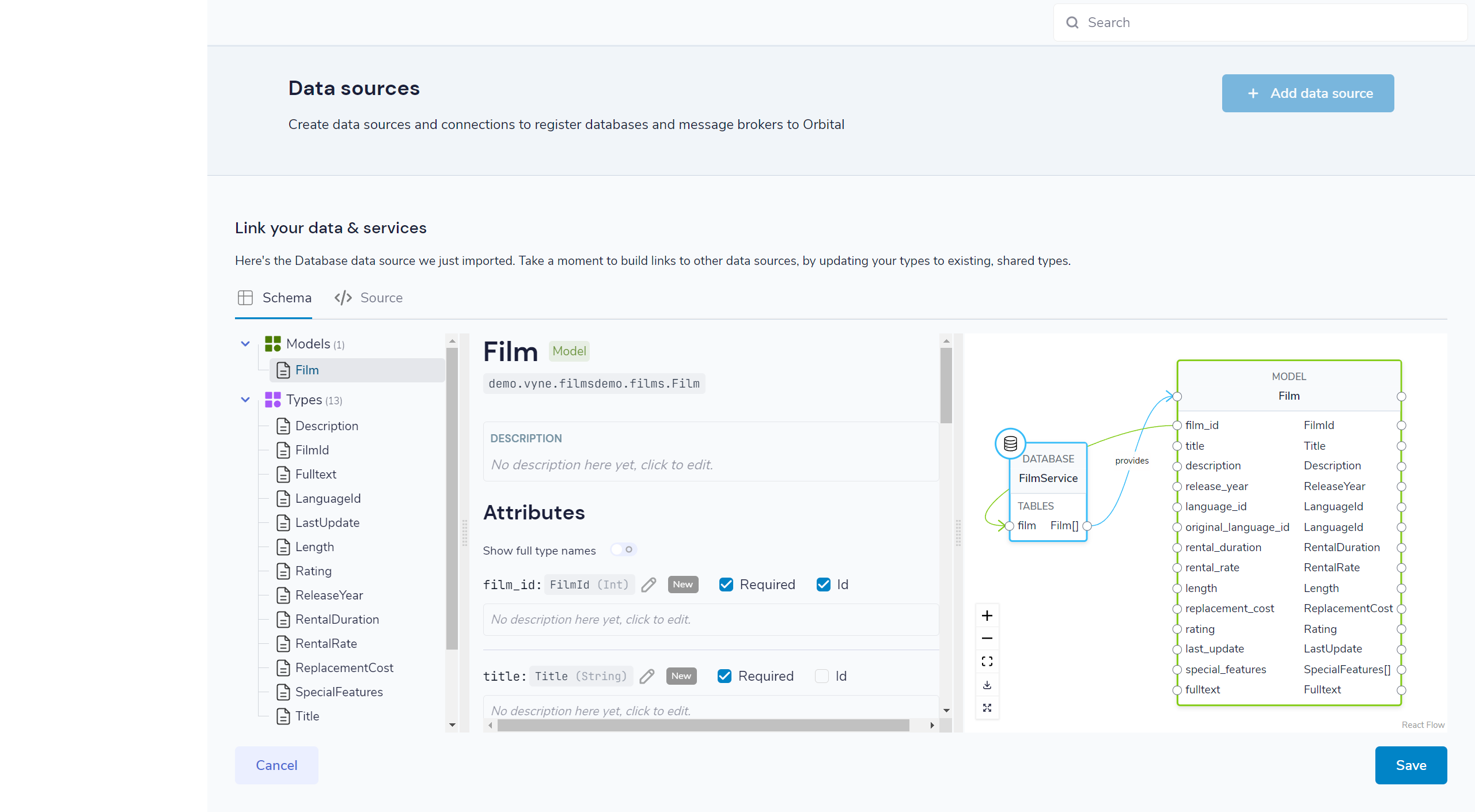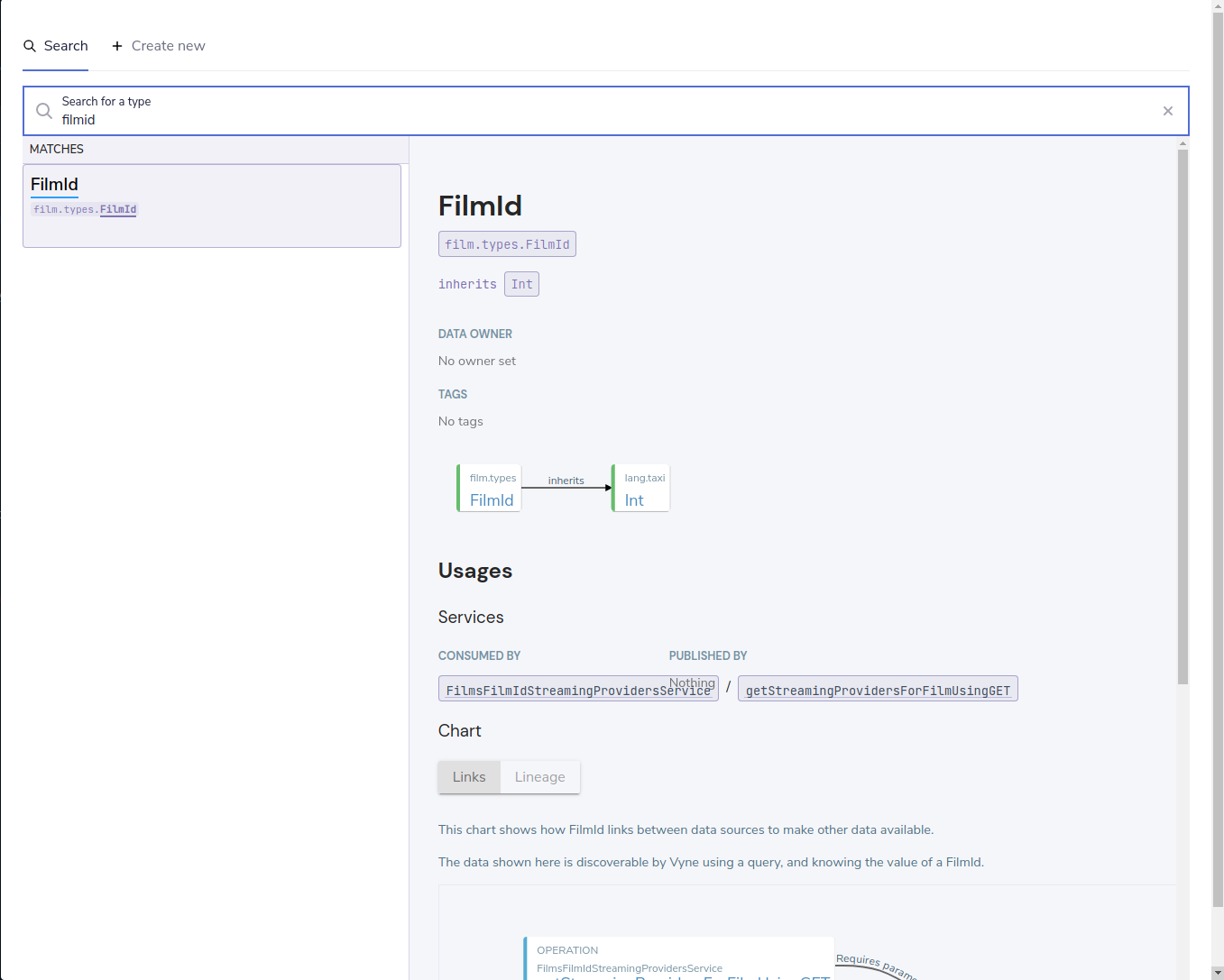Managing data sources
Describing Databases
Overview
Orbital can connect to databases to fetch data when running a query.
In order to understand the data that is present in a database table, Orbital uses a Taxi Schema for that table. The taxi schema describes the table - it’s columns and the data they hold.
Because we’re using Taxi here, the column descriptions are richer than things like String or Integer - instead using rich semantic tags like FirstName,
LastName, or EmailAddress
In this guide, we’ll learn how to create a Taxi Schema for a specific database table - both through the user interface, and by directly editing a schema
Using the UI
The UI allows you to connect a database table directly, without having manually edit taxi files. Through the UI, Orbital will connect to the database, and create:
- A series of types for each column in the database table
- A model that describes the database table
- A service that exposes query capabilities for the table
Importing a new table
- From the home page, click Add a data source.
- Alternatively, Click Schema Explorer in the left-hand navigation menu, then click “Add new”
- For the schema type to import, select “Database table”

- Click the connection name drop-down, and select the connection for your database
- If you haven’t yet created your connection, you can click “Add new connection”. This guide has more details.
- Select the table from the drop-down
- Specify a namespace for the taxi types, models and services that will be created
- Click Configure
Preview the generated types
A preview is shown, containing the models, fields and types that were imported from the Database schema.

You can change any of the types (eg., swapping a primitive type with a more specific semantic type), by clicking on the pencil icon next to the type name, and search for the desired type.
Once you’re satisfied, click Save, and the schema will be updated.
Changing the assigned types
Orbital has assigned reasonable defaults to all the fields. Specifically
- Id’s have been tagged
- Foreign keys have been mapped
- For all other fields, new semantic types have been created.
If the columns in your database map to exisitng semantic types, you may wish to update the definitions. To do this:
- Select a Model from the table on the left-hand side
- Click on the blue link for the column you wish to change the type of
- A search dialog is displayed
- From here, you can search for existing types in your catalog, or create a new type

You can also click to edit documentation for any of the types, models and services.
- Once you’re satisfied with the edits to your table and types, click Save
- The schema has been created and written to the taxi project configured in your schema server.
Required permissions
In order to view, create or edit connected database tables through the UI, users must have the following permissions granted.
| Activity | Required permission |
|---|---|
| View the connected tables | VIEW_CONNECTIONS |
| Create or modify a database table | EDIT_CONNECTIONS |
See (this guide)[/how-to-guides/auth/manage-user-permissions] for more information on role based security.
Defining a database connection in connections.conf
Instead of using the UI to add your database, you can add a database by defining a
a connection in your connections.conf file.
Here is an example for adding a Postgres database connection:
jdbc { // The root element for database connections
another-connection { // Defines a connection called "another-connection"
connectionName = another-connection // The name of the connection. Must match the key used above.
jdbcDriver = POSTGRES // Defines the driver to use. See below for the possible options
connectionParameters { // A list of connection parameters. The actual values here are defined by the driver selected.
database = transactions // The name of the database
host = our-db-server // The host of the database
password = super-secret // The password
port = "2003" // The port
username = jack // The username to connect with
}
}
}Database connections are defined under the jdbc element within the connections.conf file.
jdbc { // The root element for database connections
another-connection { // Defines a connection called "another-connection"
connectionName = another-connection // The name of the connection. Must match the key used above.
jdbcDriver = POSTGRES // Defines the driver to use. See below for the possible options
connectionParameters { // A list of connection parameters. The actual values here are defined by the driver selected.
database = transactions // The name of the database
host = our-db-server // The host of the database
password = super-secret // The password
port = "2003" // The port
username = jack // The username to connect with
}
}
}Supported drivers
Postgres
To configure a Postgres connection, specify jdbcDriver = POSTGRES
Connection parameters are as follows:
| Parameter name | Description |
|---|---|
host | The host address of the Postgres database |
port | The port to connect to. Defaults to 5432 |
database | The name of the database on the postgres server |
username | Optional. The username to use when connecting |
password | Optional. The password to use when connecting |
Example
jdbc { // The root element for database connections
another-connection { // Defines a connection called "another-connection"
connectionName = another-connection // The name of the connection. Must match the key used above.
jdbcDriver = POSTGRES // Defines the driver to use. See below for the possible options
connectionParameters { // A list of connection parameters. The actual values here are defined by the driver selected.
database = transactions // The name of the database
host = our-db-server // The host of the database
password = super-secret // The password
port = "2003" // The port
username = jack // The username to connect with
}
}
}MySQL
To configure a MySql connection, specify jdbcDriver = MYSQL
Connection parameters are as follows:
| Parameter name | Description |
|---|---|
host | The host address of the MySQL database |
port | The port to connect to. Defaults to 3306 |
database | The name of the database on the MySql server |
username | Optional. The username to use when connecting |
password | Optional. The password to use when connecting |
Example
jdbc {
mysql-docker {
connectionName=mysql-docker
connectionParameters {
database=test
host=localhost
password=my-secret-pw
port="3306"
username=root
}
jdbcDriver=MYSQL
}
}MSSQL Server
To configure a Postgres connection, specify jdbcDriver = MSSQL
Connection parameters are as follows:
| Parameter name | Description |
|---|---|
host | The host address of the MSSQL database |
port | The port to connect to. Defaults to 1443 |
database | The name of the database on the MS SQL server |
username | Optional. The username to use when connecting |
password | Optional. The password to use when connecting |
schema | Optional. The schema to use - defaults to dbo |
trustServerCertificate | Optional. Forces Orbital to trust the certificate that’s provided by the SQL Server. Defaults to true |
encrypt | Optional. Defines if the connection to MSSQL server should be encrypted. Defaults to true |
Example
jdbc {
sqlServerConnection {
connectionName=sqlServerConnection
connectionParameters {
database=Northwind
encrypt="true"
host=localhost
password=ChangeMe
port="14330"
schema=dbo
trustServerCertificate="true"
username=sa
}
jdbcDriver=MSSQL
}
}Redshift
To configure a Postgres connection, specify jdbcDriver = REDSHIFT
Connection parameters are as follows:
| Parameter name | Description |
|---|---|
host | The host address of the Redshift database |
port | The port to connect to. Defaults to 5439 |
database | The name of the database on the Redshift server |
username | Optional. The username to use when connecting |
password | Optional. The password to use when connecting |
Example
jdbc { // The root element for database connections
another-connection { // Defines a connection called "another-connection"
connectionName = another-connection // The name of the connection. Must match the key used above.
jdbcDriver = REDSHIFT // Defines the driver to use. See below for the possible options
connectionParameters { // A list of connection parameters. The actual values here are defined by the driver selected.
database = transactions // The name of the database
host = our-db-server // The host of the database
password = super-secret // The password
port = "2003" // The port
username = jack // The username to connect with
}
}
}Snowflake
To configure a Postgres connection, specify jdbcDriver = SNOWFLAKE
Connection parameters are as follows:
| Parameter name | Description |
|---|---|
account | The name of the Snowflake account |
schema | The name of the schema to connect to |
db | The name of the database to connect to |
warehouse | The name of the warehouse where the snowflake db exists |
username | The username to use when connecting |
password | The password to use when connecting |
role | The role to specify when connecting |
Example
jdbc { // The root element for database connections
another-connection { // Defines a connection called "another-connection"
connectionName = another-connection // The name of the connection. Must match the key used above.
jdbcDriver = SNOWFLAKE // Defines the driver to use. See below for the possible options
connectionParameters { // A list of connection parameters. The actual values here are defined by the driver selected.
account = mySnowflakeAccount123.eu-west-1
schema = public
db = demo_db
warehouse = COMPUTE_WH
schema = public
role = QUERY_RUNNER
}
}
}Describing tables in Taxi
Before you continue...
Before you run through this guide, it’s worth understanding the basics of taxi, and how Orbital uses it.
Also, make sure you have a taxi project set up, and that it’s been published to Orbital. If you’re running through one of our tutorials, we’ve already taken care of this for you.
Taxi files define the mappings of data models and the services that expose them. In this guide, we’ll describe how expose a new database table to Orbital, and make it queryable.
Before starting, in your taxi project, create a new file under the src/ directory. It’s up to you what
you name it. For this example, customers.taxi is a good start.
Databases, and pull-based schema definitions
As discussed in publishing schemas to Orbital, there are different ways for Orbital to consume schema information - either by data sources pushing their information directly to Orbital (well suited for application APIs), or by pulling from git-based repositories that describe the schemas.
While the push model is preferred, it’s not currently supported for databases. We’re looking into ways to embed Taxi metadata into DDL schema definitions. For now, you’ll need to maintain taxi definition file that describes the database.
Defining a table mapping
Tables are exposed to Orbital using the annotation @com.orbitalhq.jdbc.Table on a model.
Fields names in the model are expected to align with column names from the database.
Here’s an example:
import com.orbitalhq.jdbc.Table
@Table(connection = "films-database", schema = "public" , table = "customer" )
model Customer {
@Id // Use @Id to denote the primary key
customerId : CustomerId
firstName : CustomerFirstName? // Nullable columns should have the Taxi nullable symbol
lastName : CustomerLastName
}The @Table annotation contains the following parameters:
| Parameter | Description |
|---|---|
| connection | The name of a connection, as defined in your connections configuration file. |
| schema | The name of the schema. Optional, depending on your database |
| table | The name of the table |
It’s possible to use environment variables in these annotations, as described here.
Mapping the primary key
Use an @Id annotation to define the column that represents the primary key. At this stage, composite keys
are not supported.
Querying databases
To expose a database as a source for queries, the database must have a service and table operation exposed.
Here’s an example:
import com.orbitalhq.jdbc.DatabaseService
@DatabaseService(connection = "films-database")
service CustomerService {
table customers : Customer[]
}The @DatabaseService annotation contains the following parameters:
| Parameter | Description |
|---|---|
| connection | The name of a connection, as defined in your (connections configuration file)[/how-to-guides/connections/manage-database-connection/#defining-a-database-connection]. |
Sample queries
Fetch everything from a table:
find { Customer[] }Fetch a single value from a table:
find { Customer( CustomerId == 123 ) }Fetch values by criteria:
find { Customer[]( DateOfBirth <= '1989-10-01' && CountryOfBirth == 'NZ' ) }Join two tables
find { Customer[] } as (customer:Customer) -> {
name : FirstName
// defines a join between the Customer and Purchase tables
purchases : Purchases[](CustomerId == customer.id)
}Join two tables, transforming data
find { Customer[] } as (customer:Customer) -> {
name : FirstName
// defines a join between the Customer and Purchase tables
purchases : Purchases[](CustomerId == customer.id) as {
// Inside this scope we have access to both Customer data and Purhcase data
productName : ProductName
price : ProductPrice
// Be sure to include the array marker, as we're defining an array of
// objects (Purchase[] -> OurType[])
}[] // <--- array marker
}Fetching from a database, enrich from another source
As with all TaxiQL queries, enriching data from multiple sources requires simply asking for the data you need - Orbital works out the correct integration.
Assuming a schema with a database such as:
import com.orbitalhq.jdbc.Table
import com.orbitalhq.jdbc.DatabaseService
@Table(connection = "customers-database", schema = "public" , table = "customer" )
closed model Customer {
@Id
id : CustomerId inherits Int
name : CustomerName inherits String
}
@DatabaseService(connection = "customers-database")
service CustomerService {
table customers : Customer[]
}And we also have an API that exposes balance information:
closed model CustomerBalance {
customerId : CustomerId
balance : CurrentBalance
}
service AccountBalanceService {
@HttpOperation(url="https://fakeurl/customers/{id}/balance", method = "GET" )
operation getCustomerBalance(@PathVariable id:CustomerId):CustomerBalance
}The below call assumes we’re fetching customer details from our database, then enriching against an API call (API )
find { Customer(CustomerId == 123) } as {
name : CustomerName // this information comes from the database
currentBalance : CurrentBalance // An API call is made to fetch account balance
}Or, to fetch that same data for all customers:
find { Customer[] } as {
name : CustomerName // this information comes from the database
currentBalance : CurrentBalance // An API call is made to fetch account balance
}[]Using IN and NOT IN operators
When querying databases, you can use in and not in operators to filter against multiple values at once. This is more efficient than using multiple OR conditions and generates optimized SQL.
Filtering with IN operator
To find records where a field matches any value in a list:
// Find customers with specific IDs
find { Customer[]( CustomerId in [123, 456, 789] ) }// Find customers from specific countries
find { Customer[]( CountryOfBirth in ["US", "UK", "CA"] ) }Filtering with NOT IN operator
To find records where a field does not match any value in a list:
// Find customers excluding specific IDs
find { Customer[]( CustomerId not in [123, 456] ) }// Find customers not from specific countries
find { Customer[]( CountryOfBirth not in ["US", "UK"] ) }Combining with other conditions
IN and NOT IN operators can be combined with other conditions using && (AND) and || (OR):
// Find active customers from specific countries
find { Customer[]( CountryOfBirth in ["US", "UK", "CA"] && Status == "ACTIVE" ) }// Find customers either VIP or from specific regions
find { Customer[]( CustomerType == "VIP" || CountryOfBirth in ["US", "UK"] ) }Both in and not in work with any data type - strings, numbers, dates, and custom semantic types.
Writing data to a database
To expose a database table for writes, you need to provide a write operation in a service,
specifying the write behaviour:
import com.orbitalhq.jdbc.Table
import com.orbitalhq.jdbc.DatabaseService
import com.orbitalhq.jdbc.UpsertOperation
@Table(connection = "customers-database", schema = "public" , table = "customer" )
closed model Customer {
@Id
id : CustomerId inherits Int
name : CustomerName inherits String
}
@DatabaseService(connection = "customers-database")
service CustomerService {
table customers : Customer[]
@UpsertOperation
write operation saveCustomer(Customer):Customer
}In this example, the saveCustomer operation will attempt to perform an upsert.
| Write behaviour | Annotation | Comments |
|---|---|---|
| Insert | com.orbitalhq.jdbc.InsertOperation | |
| Update | com.orbitalhq.jdbc.UpdateOperation | Requires an @Id field |
| Upsert | com.orbitalhq.jdbc.UpsertOperation | Falls back to an insert if no @Id is defined |
Table creation
If the database table does not exist, Orbital will create it when first attempting to write.
If the database table does exist, but with a different schema, writes may fail.
No schema migrations are performed.
Example queries
When writing data from one data source into a database, it’s not neccessary for the data to align with the format of the persisted value.
Orbital will automatically adapt the incoming data to the format required by the db.
This may involve projections and even calling additional services if needed.
Inserting a static value into a database
// inserting a static value into a database
given { customer : Customer =
{
customerId : 123,
name : "Jimmy Smitts"
}
}
call CustomerService::saveCustomerStream data from Kafka into a database
import com.orbitalhq.jdbc.Table
import com.orbitalhq.jdbc.DatabaseService
import com.orbitalhq.jdbc.UpsertOperation
// Common, shared types:
type StockSymbol inherits String
type StockPrice inherits Decimal
// Database definitions:
@Table(connection = "prices-database", schema = "public" , table = "stock-price" )
closed model StockPrice {
@Id
symbol : StockSymbol
price : StockPrice
}
@DatabaseService(connection = "prices-database")
service PriceService {
table stockPrices : StockPrice[]
@UpsertOperation
write operation savePrice(StockPrice):StockPrice
}
// Kafka definitions:
// Note that field names don't align - orbital
// handles this for us.
closed model PriceUpdateMessage {
ticker : StockSymbol
lastTradedPrice : StockPrice
}Then, the query:
stream { PriceUpdateMessage }
call PriceService::savePriceOrbital writes each message received from Kafka into the db - creating the
table if required, and transforming the Kafka message to the format defined by
StockPrice